 One of my readers asked for information about the Scottish Fold. She said years ago she’d had one visit her. She lived on a farm, and had four other cats. The Scottish Fold jumped in a window she kept open for her cats, looking for food. She was pretty sure it was a stray, as it seemed very skittish. She said she tried to befriend it, but it just wasn’t interested. Too bad for the cat, as it probably missed a chance for a wonderful new home. She asked that I write about the breed. Fine with me — I, too, can learn something about these cats, as I have never even seen one, except in pictures.
One of my readers asked for information about the Scottish Fold. She said years ago she’d had one visit her. She lived on a farm, and had four other cats. The Scottish Fold jumped in a window she kept open for her cats, looking for food. She was pretty sure it was a stray, as it seemed very skittish. She said she tried to befriend it, but it just wasn’t interested. Too bad for the cat, as it probably missed a chance for a wonderful new home. She asked that I write about the breed. Fine with me — I, too, can learn something about these cats, as I have never even seen one, except in pictures.
I discovered that the Scottish Fold, as a breed, is considered very affectionate. It likes people, and get along well with children and other animals.
The cat has a life span of 11 to 14 years.
ORIGIN OF THE BREED
As the name suggests, this breed originated in Scotland. The earliest Scottish Fold was a white cat named Susie who was a mouser in a barn in the Tayside region of Scotland.
In 1961, a shepherd named William Ross noticed her. When she had kittens, he got a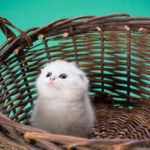 female that he named “Snooks.” She had kittens, and William bred one of them, a male, to a British Shorthair. Thus was born a new breed, named the Scottish Fold.
female that he named “Snooks.” She had kittens, and William bred one of them, a male, to a British Shorthair. Thus was born a new breed, named the Scottish Fold.
It was discovered that the gene mutation for the folded ear was dominant, so if one parent had the fold, the kittens would have them as well.
CONFLICT ABOUT THE BREED
The Scottish Fold was imported to the United States in 1971, and have been bred to both American and British Shorthairs. In Scotland, the animal is no longer recognized as a breed. There is concern among Scottish veterinarians that the folded ear may lead to ear infections or deafness. Also, there is a related cartilage problem that could lead to other skeletal issues.
THIS CAT IS FOND OF STRANGE CAT POSITIONS
The Scottish Fold has a habit of posing in odd positions. He likes to lie on his back with all his paws in the air. He also likes to sit with his back legs out in front of him and his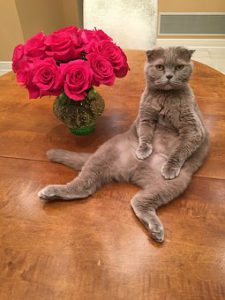 paws folded over his tummy. This position has been called the “Buddha position.” In addition, he frequently stands on his hind legs.
paws folded over his tummy. This position has been called the “Buddha position.” In addition, he frequently stands on his hind legs.
SCOTTISH FOLD PERSONALITY TRAITS
This cat is quite smart and moderately active. He enjoys the challenge of puzzle toys. However, his favorite activity is interacting with people. He likes to get involved in whatever his human family is doing. He would much rather the family be nearby, as he does not like being left alone for long periods of time. If you have a Scottish Fold, you might find it best to get a second cat to keep him company.
As he is friendly and laid-back, he is a great choice for families with children or dogs that tolerate cats. The cat loves the attention, and likes to play. He is smart, so is capable of learning tricks.
He is a sweet, calm cat who is very adaptable to all kinds of environments. He likes to play fetch or follow people around the house, so you should never feel lonely. Though the 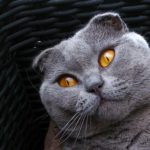 cat is not talkative, he will meow, but in a very soft voice.
cat is not talkative, he will meow, but in a very soft voice.
CARE CONSIDERATIONS
If you have a long-haired Scottish Fold, combing the cat weekly is a good idea, to remove dead hair.
Also, check the ears weekly, especially if tightly folded. If they are dirty, you can clean them with a cotton ball or a soft, damp cloth moistened with a mix that is half vinegar and half warm water. Do not clean with cotton swabs, as they can damage the interior of the ear.
PHYSICAL CHARACTERISTICS
Because his ears fit his rounded head like a cap, he is often said to resemble an owl. The ears may be a single fold or a double, somewhat tighter fold. A triple fold is also possible, and is desirable for show cats.
The kittens’ ears are straight when they are born. The ears may or may not fold when the kittens are about 3 weeks old. Their body is medium-sized and rounded. The tail is medium to long, and sometimes has a rounded tip.
The cat’s coat is dense and soft. The Scottish Fold may be any number of colors and 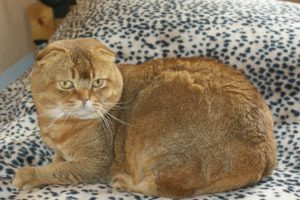 patterns. These include solid, tabby, tabby and white, and bi color. The long-haired version of the breed is known as the Highland Fold.
patterns. These include solid, tabby, tabby and white, and bi color. The long-haired version of the breed is known as the Highland Fold.
I’m sending a thank you to an internet site called “Cattime.com” for this good information.
BREED BANNED BY BRITISH VETERINARY ASSOCIATION
The British Veterinary Association warns that breeding of the Scottish Folds should stop because of health issues. Their ears are the result of a genetic condition that could lead to short and painful lives.
The ear cartilage is deformed, which is what causes the ears to fold This cartilage mutilization can cause problems in other parts of the cat’s body. The mutation can develop into a lifelong incurable and painful disease, such as arthritis.
This arthritis can develop in their tails at a young age. As the condition is very painful, you may notice your Scottish Fold cat pulling away if you try to pet his tail, or perhaps he holds it very stiffly. Ask you vet to examine his tail during a routine visit.
From a report on the BBC News, I learned that the GCCF (Governing Council of the Cat Fancy) of the UK stopped registering the cats because of their concerns regarding ear disorders and hearing problems. However, the breed is still popular in the United States.
What do you think? Would it be more humane not to breed these cats anymore? Give your opinion in the comments section below. I would love to hear from you.

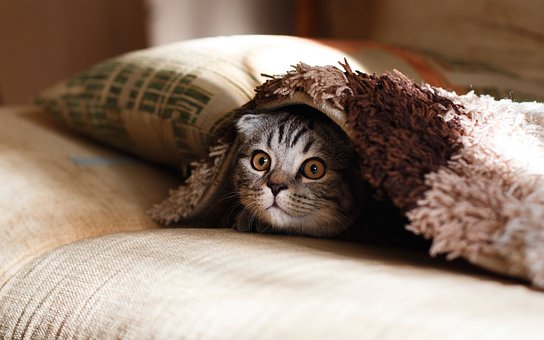
Hello Fran, these Scottish cats are very adorable and they look so cute. I love the way they sit although it can be strange for some people. However, the sad thing about these cats is how they have a short life span. I wish they could live a bit longer. It will be a joy of my if I could have one of those cats in the future. I will book this page for future references. Thanks for the nice post.
Kuu, I am so glad you liked the post. They are funny little cats, aren’t they? It amuses me, too, that they sit that way. As for the short life span, I think it is sad that all our pets have such a short life span, compared to ours. It gives us too many chances to grieve, which is not my favorite activity. Also thanks for bookmarking. It is nice to know you liked the story enough to do that.